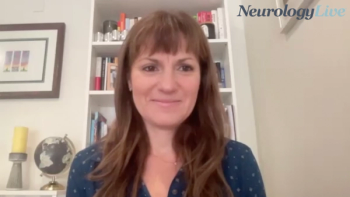
Case 1: 15-Year-Old Female With Excessive Daytime Sleepiness
Russell Rosenberg, PhD, DABSM, and Margaret Park, MD, review the case of a 15-year-old girl who presents with excessive daytime sleepiness and share clinical impressions on diagnosis and treatment.
Episodes in this series

Russell Rosenberg, PhD, DABSM: Now, let’s get to our case. This is a 15-year-old girl who presents to a psychiatric clinic with excessive daytime sleepiness, which she has experienced for the last year. Her liver, renal, and thyroid functions and bloodwork are perfectly normal. One year before the time that she came to the clinic, she was treated for typhoid and malaria. Within a week of starting on typhoid and malaria medications, she started complaining of excessive daytime sleepiness, which was initially attributed to weakness from fever. And within 2 months after the initial presentation of excessive sleepiness, she started noticing weakness of limbs while laughing or getting angry, which led her to falling several times. Her grades started to fall then, and she could not concentrate well on schoolwork. She also started hallucinating about someone standing next to her during excessive daytime sleepiness episodes, and her symptoms continued to increase over time. She visited many physicians, a neurologist, and psychologist. During this time, she was eventually diagnosed with schizophrenia and depression. She does not have any depression, schizophrenia, or narcolepsy history in her family. She was initially started on fluoxetine and risperidone, with no improvement over 2 months in her symptoms. There’s a lot to unpack there, Margaret, but why don’t you take a swing at some of the things that stick out to you?
Margaret Park, MD: Yes, well, again, from a very bio-sleep perspective, this is screaming narcolepsy to me. She matches multiple symptoms, but let’s march through it a little. The most important thing to recognize here is what is she presenting with? She is presenting with sleepiness. We have to remember that when people come to us for evaluation, they have a specific concern, and whatever else that we find, eventually we need to come back to that concern. She is presenting with sleepiness. She’s not presenting with mood issues, or fluctuations of issues, or all these other things. She’s saying, “I am sleepy, and this all happened after I had this weird infection that happened.” Now, historically, we don’t know why certain things express when they do, right? When we go through all of our science courses and medical genetics and things like that, we know that we all have some sort of genetic predisposition, something comes along to hit that expression, and then we express, and it’s something that manifests. We know anecdotally and from research that various infections can trigger these symptoms. A lot of times people do say, “I had that weird bout of mono that happened,” or, “Hey, I had that strep infection,” or in this case, “I had malaria and typhoid.” We know that even in modern times, most recently with the H1N1 flu, and even the vaccines for H1N1, and all these other things coming up that we know people can sometimes identify, “I was totally OK, then this thing happened. Then after that, I was just really sleepy.”
When that occurs, it’s important to realize that while this may happen with certain psychiatric disorders, usually it’s not this specific, where they’re like, “I was sick and now I’m sleepy. Not depressed. I was tired, I’m sleepy, something changed.” I think that is a very specific presentation that to me says, hey, there is something that triggered some sleepiness issues, not to mention that she is presenting with the hypnagogic/hypnopompic hallucinations. She very clearly identifies cataplexy. This is a very specific symptom that she’s describing, that is associated with these specific emotional triggers. This is, unfortunately, not an uncommon scenario where something happens, “I’m sleepy; I have these other weird things like these hallucinations that occur.” And keep in mind that she specifically does say these hallucinations occur around sleep phenomenon. She’s not having them when she’s completely alert and awake and feeling and interactive with people. She doesn’t hear these voices. She’s specifically seeing something visual around the sleep phenomenon. For me, this indicates this is all sleep-related. She definitely needs a sleep work-up.
Russell Rosenberg, PhD, DABSM: Yes, I agree. I think the insult here is the malaria and the insult to her orexin neurons, it’s the destruction of those neurons that leads to these symptoms of narcolepsy type 1. What about the work-up? What does she need to undergo to get a formal diagnosis?
Margaret Park, MD: From my perspective, obviously, a lot of these patients already have had something. I do ask for that; I redefine a lot of the history. I specify everything she goes over, and I do go over specific sleep habits. We want to make sure that these patients are adhering to a specific sleep routine. If they’re sort of sleeping all over the place, or they’re jet-lagged, or they’re doing shift work, or they’re doing a lot of substance usage, whether it’s caffeine or THC [tetrahydrocannabinol] or alcohol or other substances. We want to make sure that is all in line. We do get a very thorough history, a thorough sleep history. And again, a lot of these people, especially in this particular case, she’s already seen neurologists and psychiatrists and everything. I do ask for things like blood tests and MRIs, and EEGs [electroencephalograms], whatever she’s gotten done. But even in the absence of that, I absolutely move forward with an overnight sleep study and a next-day MSLT [multiple sleep latency test]. The overnight study is obviously a bunch of wires to look at different physiological parameters that occur during sleep, which include breathing and movements, but also very importantly, the sleep staging via brain waves.
Then that is followed by a next-day nap challenge, where you wake up, do what you need to do, but every 2 hours, we say turn everything off and take a nap. Thus, it is a nap challenge where we measure how quickly you fall asleep according to your brainwaves, not your subjective perception. There are still electrodes. It’s not a perfect test, but it’s pretty darn good. It’s really nice because it centers on the patient’s symptoms. You are sleepy, let us test your 24-hour system, let us see what your overnight looks like, let’s see what your daytime brainwaves look like. This is very reflective of that sleep-wake instability that we were talking about, because of the lack of that orexigenic influence in patients with narcolepsy, and whether that lack of influence occurs because of just innate genetics, or an inflammatory or immunological insult, or even trauma. We know that there are certain brain hemorrhages or brain tumors and things like that, that can also induce orexigenic insult. This test doesn’t discriminate among the cause of it. It just tests what that outcome looks like.
Transcript Edited for Clarity
Presentation
- A 15-year-old girl presents to a psychiatric clinic with excessive daytime sleepiness which she has experienced for the last 1 year.
Lab Results
- Her liver, renal and thyroid functions and blood work are normal.
Past Medical History
- One year before presentation to the psychiatric clinic, she was treated for typhoid and malaria.
- Within a week of starting on typhoid and malaria medications, she started complaining of EDS, which was initially attributed to weakness from fever.
- Within 2 months after initial presentation of EDS, she started noticing weakness of limbs while laughing or getting angry, which led to her falling several times.
- Her grades started to fall as she could not concentrate on schoolwork.
- She also started hallucinating about someone standing next to her during EDS episodes and her symptoms continued to increase over time.
- She visited many physicians, neurologist and psychologists during this time and was eventually diagnosed with schizophrenia and depression.
- She does not have any depression, schizophrenia or narcolepsy history in her family.
Treatment
- She started treatment on fluoxetine and risperidone with no improvement over 2 months in her symptoms.
Newsletter
Keep your finger on the pulse of neurology—subscribe to NeurologyLive for expert interviews, new data, and breakthrough treatment updates.































